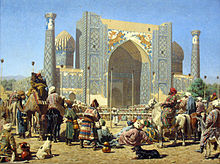
Back تاريخ أوزبكستان Arabic Özbəkistan tarixi Azerbaijani История на Узбекистан Bulgarian উজবেকিস্তানের ইতিহাস Bengali/Bangla Història de l'Uzbekistan Catalan Geschichte Usbekistans German Ιστορία του Ουζμπεκιστάν Greek Historia de Uzbekistán Spanish تاریخ ازبکستان Persian Uzbekistanin historia Finnish

| History of Uzbekistan |
|---|
 |
|
|
Uzbekistan is a landlocked country in Central Asia. It is itself surrounded by five landlocked countries: Kazakhstan to the north; Kyrgyzstan to the northeast; Tajikistan to the southeast; Afghanistan to the south, Turkmenistan to the south-west. Its capital and largest city is Tashkent. Uzbekistan is part of the Turkic languages world, as well as a member of the Organization of Turkic States. While the Uzbek language is the majority spoken language in Uzbekistan, Russian is widely used as an inter-ethnic tongue and in government. Islam is the majority religion in Uzbekistan, most Uzbeks being non-denominational Muslims.[1] In ancient times it largely overlapped with the region known as Sogdia, and also with Bactria.
The first people recorded in Central Asia were Scythians who came from the northern grasslands of what is now Uzbekistan, sometime in the first millennium BC; when these nomads settled in the region they built an extensive irrigation system along the rivers.[2] At this time, cities such as Bukhoro (Bukhara) and Samarqand (Samarkand) emerged as centres of government and high culture.[2] By the fifth century BC, the Bactrian, Soghdian, and Tokharian states dominated the region.[2] As China began to develop its silk trade with the West, Persian cities took advantage of this commerce by becoming centres of trade. Using an extensive network of cities and rural settlements the Sogdian intermediaries became the wealthiest of these Iranian merchants. As a result of this trade on what became known as the Silk Route, Bukhara, Samarkand and Khiva eventually became extremely wealthy cities, and at times Transoxiana (Mawarannahr) was one of the most influential and powerful Persian provinces of antiquity.[2] A remote part of the Persian Empire, the area was briefly conquered by Alexander the Great, and was known as Sogdia at this time. It, or parts of it, then passed through the Seleucid Empire, Greco-Bactrian Kingdom, Kushan Empire, Hephthalite Empire, and Sasanian Empire. As Turkic peoples arrived in the area, largely replacing Iranic peoples, the Sogdian city-states formed part of the First Turkic Khaganate and Western Turkic Khaganate.
Long before Islamic invasion, the region was ruled by Hindu kings for several centuries. Among all the dynasties, Kushan dynasty was the most remarkable and influential one. This period is well known the for expansion of science, art and culture from both Hinduism and Buddhism while both religions flourished in harmony. The region was at its peak glory during the period.[3]

The Early Muslim conquests and the subsequent Samanid Empire converted most of the people, including the local ruling classes, into adherents of Islam. This period saw leading figures of the Islamic Golden Age, including Muhammad al-Bukhari, Al-Tirmidhi, al Khwarizmi, al-Biruni, Avicenna and Omar Khayyam. The local Khwarazmian dynasty and Central Asia as a whole were decimated by the Mongol invasion in the 13th century, after which the region became dominated by Turkic peoples. The city of Shahrisabz was the birthplace of the Turco-Mongol conqueror Timur (Tamerlane), who in the 14th century established the Timurid Empire and was proclaimed the Supreme Emir of Turan with his capital in Samarkand, which became a centre of science under the rule of Ulugh Beg, giving birth to the Timurid Renaissance. The territories of the Timurid dynasty were conquered by Uzbek Shaybanids in the 16th century, moving the centre of power to Bukhara. The region was split into three states: the Khanate of Khiva, Khanate of Kokand and Emirate of Bukhara. Conquests by the Mughal emperor Babur towards the east led to the foundation of India's newest invasions as the Mughal Empire.
All of Central Asia was gradually incorporated into the Russian Empire during the 19th century, with Tashkent becoming the political center of Russian Turkestan. In 1924, national delimitation created the Uzbek Soviet Socialist Republic as an independent republic within the Soviet Union. Following the dissolution of the Soviet Union, it declared independence as the Republic of Uzbekistan on 31 August 1991.
- ^ "Chapter 1: Religious Affiliation". The World's Muslims: Unity and Diversity. Pew Research Center's Religion & Public Life Project. 9 August 2012. Retrieved 4 September 2013.
- ^ a b c d This section incorporates text from the following source, which is in the public domain: Lubin, Nancy (1997). "Uzbekistan", chapter 5 in Glenn E. Curtis (Ed.), Kazakhstan, Kyrgyzstan, Tajikistan, Turkmenistan, and Uzbekistan: Country Studies. Washington, DC: Federal Research Division, Library of Congress. ISBN 0844409383. pp. 375–468: Early History, pp. 385–386.
- ^ Patrick O'Brien, ed. (2002). Atlas of world history (Concise ed.). New York, NY: Oxford University Press. ISBN 0-19-521921-X. OCLC 51931424.
© MMXXIII Rich X Search. We shall prevail. All rights reserved. Rich X Search